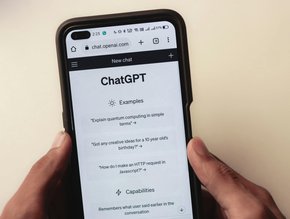Robots and drones demanding data for life-or-death decisions

When disaster strikes or building inspections are required, drones and robots must rely on the most up-to-date information to effectively locate survivors or identify potential hazards. However, the simultaneous transmission of time-sensitive data from multiple sources over a wireless network can lead to a bottleneck, rendering the received data stale and unusable.
Researchers at MIT have developed a solution to this issue by creating a method to optimise wireless networks for the efficient handling of high-volume, time-sensitive data from various sources. Dubbed WiSwarm, this new approach configures a wireless network to manage information flow from multiple sources while prioritising and transmitting the freshest data.
The team demonstrated WiSwarm's efficacy by modifying a standard wifi router. The adjusted network acted as a proficient traffic controller, enabling it to prioritise and relay the most recent data to maintain the efficiency of multiple vehicle-tracking drones.
Scheduled for presentation at IEEE's International Conference on Computer Communications (INFOCOM) in May, WiSwarm offers a practical solution for multiple robots to communicate over existing wifi networks. This eliminates the need for bulky, costly communication and processing equipment on board the robots.
The study's authors from MIT's Laboratory for Information and Decision Systems (LIDS) include Vishrant Tripathi, Ezra Tal, Muhammad Shahir Rahman, Alexander Warren, Sertac Karaman, and Eytan Modiano.
“Imagine self-driving cars come to an intersection that has a sensor that sees something around the corner,” says Karaman. “Which car should get that data first? It’s a problem where timing and freshness of data matters.”
Robots looking for the freshest plate from the kitchen
The team’s approach departs from the typical way in which robots are designed to communicate data.
“What happens in most standard networking protocols is an approach of first come, first served,” says Tripathi. “A video frame comes in, you process it. Another comes in, you process it. But if your task is time-sensitive, such as trying to detect where a moving object is, then all the old video frames are useless. What you want is the newest video frame.”
In theory, adopting a "last in, first out" strategy could help maintain data freshness. This idea resembles a chef serving dishes one at a time as they come straight from the kitchen. To get the freshest plate, you would opt for the latest one added to the queue. Similarly, for data, prioritising the "age of information" ensures access to the most current information available.
“Age-of-information is a new metric for information freshness that considers latency from the perspective of the application,” says Modiano. “For example, the freshness of information is important for an autonomous vehicle that relies on various sensor inputs. A sensor that measures the proximity to obstacles in order to avoid collision requires fresher information than a sensor measuring fuel levels.”
Researchers have focused on prioritising age-of-information by implementing a "last in, first out" protocol for multiple robots working together on time-sensitive tasks. They aimed to achieve this over conventional wireless networks, as wifi is widely available and does not require bulky onboard communication hardware.
However, wireless networks have a significant drawback: their distributed nature means that they do not prioritise data reception from any single source. Consequently, a wireless channel can quickly become congested when multiple sources send data simultaneously. Even with a "last in, first out" protocol, data collisions would occur, causing system failure in time-sensitive operations.
To overcome this challenge, the team developed WiSwarm, a scheduling algorithm that can be executed on a centralised computer and paired with any wireless network to manage multiple data streams while prioritising the freshest data.
The algorithm determines which source in a network should send data next, rather than attempting to receive every data packet from every source at every moment. The selected source - which could be a drone or robot - then follows a "last in, first out" protocol to transmit the most recent data through the wireless network to a central processor.
WiSwarm's decision-making process is based on three parameters: a drone's general priority (a drone tracking a fast vehicle may need more frequent updates and therefore has higher priority over a drone tracking a slower vehicle, for example); the age of information, or the time since the drone last sent an update; and the drone's channel reliability or likelihood of successfully transmitting data.
By evaluating these three parameters for each drone at any given time, the algorithm can schedule drones to send updates one at a time through a wireless network without causing congestion, while providing the freshest data for successfully completing time-sensitive tasks.
Images over wifi keep drones on track
The team tested their algorithm using multiple mobility-tracking drones equipped with a small camera and a basic wifi-enabled computer chip, which they used to continuously send images to a central computer without the need for bulky onboard computing systems. The drones were programmed to fly over and follow small, randomly moving ground vehicles.
When the researchers paired the network with the WiSwarm algorithm, the computer successfully received the freshest images from the most relevant drones, which it then used to send commands back to the drones to keep them on the vehicles' tracks.
In experiments with two drones, the WiSwarm method relayed data that was twice as fresh and resulted in six times better tracking compared to using wifi alone. When the system was expanded to include five drones and five ground vehicles, wifi alone could not handle the increased data traffic, causing the drones to lose track of the vehicles. However, WiSwarm-equipped networks were better prepared, allowing all drones to maintain tracking of their respective vehicles.
“Ours is the first work to show that age-of-information can work for real robotics applications,” says Tal.
Soon affordable and agile drones could collaborate and communicate via wireless networks to perform tasks such as examining buildings, agricultural fields, and renewable energy installations like wind and solar farms. Looking further ahead, this approach could prove crucial for handling data flow throughout smart cities.






